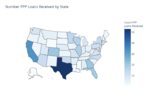wingclipper
Well-Known Member
Man, I need to tune in more often. He just suggested to the doctors that we should be exploring injecting disinfectants because they work on surfaces
Save your sanity and deny him the attention. Anything worth your attention will be highlighted ad nausium through cable news.Man, I need to tune in more often. He just suggested to the doctors that we should be exploring injecting disinfectants because they work on surfaces
What in the fuck
TBH, I hope they all drink bleach.So after his last suggestion someone died eating aquarium cleaner, i hope no one tries drinking bleach this time
Or injecting it.So after his last suggestion someone died eating aquarium cleaner, i hope no one tries drinking bleach this time


If I'm understanding your graphs correctly, it's not that straightforward. If Texas had a much larger number of applications, they still could have had many more successful applications than S Dakota, but a lower percentage of the total applications.View attachment 42885
View attachment 42886
Source: COVID Loan Tracker
The first graph shows by state the number of loan applications successfully completed.
The second shows by state the number of loans actually received with the first round of small business loans
I find it interesting that that while having a lot less applications than other states, Texas by far had the most approved and paid out.
Wonder what that's all about.
If I'm understanding your graphs correctly, it's not that straightforward. If Texas had a much larger number of applications, they still could have had many more successful applications than S Dakota, but a lower percentage of the total applications.
I did read that basically one dude from Texas has gotten more loans than anyone else though. Was that shared on here? Can't remember.
The title of the first chart is percent successful by state.The way I read it it wasn't a percentage. But rather totals.
So for example, South Dakota has the most total number of applications. Texas that the most total number of paid loans.
As for that article you mention. I don't think it has been posted here. I'm not familiar with it.

 www.fortworthbusiness.com
www.fortworthbusiness.com

More on states declaring bankruptcy.
Currently under federal law it is illegal for a state to declare bankruptcy.
However, the message from the Trump administration and Mitch McConnell is no bail out for blue states, they should file for bankruptcy.
The idea is currently being floated around the senate to draft legislation to allow for states to file for bankruptcy.
The biggest financial strain on states have been pensions. Many states have had chronic underfunding issues with pensions going back to and a little before the Great Recession. Many states have been attempting to clawback previous promised pension benefits.
This is an issue both blue and red states face, but this effects blue states more than red states because blue states have higher populations, likely had better pension benefits and have more government employees. If you think about it, public transit employees get state pension money. How many rural red states have extensive public transportation? Blue states also of more government programs to manage. I know at least in MA 401k has been adopted by many government positions over pension plans for new hires only for the last 10 to 15 years. But There are still many people grandfathered into pension plans.
When it comes to COVID-19. Blue states due to their higher population density were much harder hit. Also blue states like Massachusetts have public healthcare options. The response to COVID-19 is blowing through state budgets at an alarming rate.
Mitch McConnell blames blue states for not being able to properly run their states and manage their budgets. There will be no federal bail out to blue states, they should be able to manage their own state.
What happens if a state does file for bankruptcy? Nothing good, that's for sure.
But one thing we can expect is that millions of people will lose their pension benefits / retirement should multiple blue states be forced into bankruptcy.
We are also likely to see another great recession for years if states are forced to file for bankruptcy.
